Author: Biteye Core Contributor Viee
Editor: Biteye Core Contributor Denise
Recently, BNB has experienced a remarkable structural market trend. After reaching its ATH in July, it has once again surpassed ATH at $865.68 today. Accompanied by several U.S. listed companies making significant purchases of BNB as asset reserves, as well as favorable ETF applications, the market has come to see BNB, previously considered a "exchange platform token" + "public chain ecological token," as evolving towards an "institutional reserve asset."
This market movement may not just be a temporary hype but rather a reassessment and repositioning of BNB's value. This article will delve into BNB's "institutionalization" path and various opportunities that retail investors can participate in.
01. Review of BNB's "Institutional Evolution" Path
In the past two months, three major events have occurred surrounding BNB:
Multiple U.S. companies have incorporated BNB into their asset reserves: since July, several U.S. listed companies have announced plans to purchase or raise funds to configure BNB: for instance, CEA Industries plans to raise $500 million (up to $1.2 billion) with the support of Yzi Labs to create the largest BNB reserve; Liminatus Pharma intends to invest up to $500 million in long-term BNB investments; Windtree Therapeutics approved up to $700 million for the acquisition of BNB; Nano Labs plans to invest $1 billion to gradually hold 5% to 10% of the circulating BNB supply, having already purchased 128,000 BNB over the counter. This series of measures indicates that some institutions view BNB as a reserve asset comparable to Bitcoin.
ETF Wind: In early May, renowned asset management company VanEck formally submitted an application for a BNB ETF to the U.S. SEC, including staking and additional benefits. If approved, BNB is expected to become the focus of the next round of crypto ETF competition following Bitcoin and Ethereum.
BNB price breaks through historical highs: Due to the resonance of the above benefits, BNB continues to strengthen, reaching a historical high of $865.68 on August 14. The chart below shows that since mid-July, the weighted funding rate for BNB holdings has continuously risen from negative to positive, frequently surging to about 0.015%–0.03%/8h between 7/23 and 8/14, rising in sync with the price; during the pullback phase, it did not turn negative for long, indicating bullish dominance, with both spot and leverage driving up the price, significant upward momentum and a relatively healthy structure.
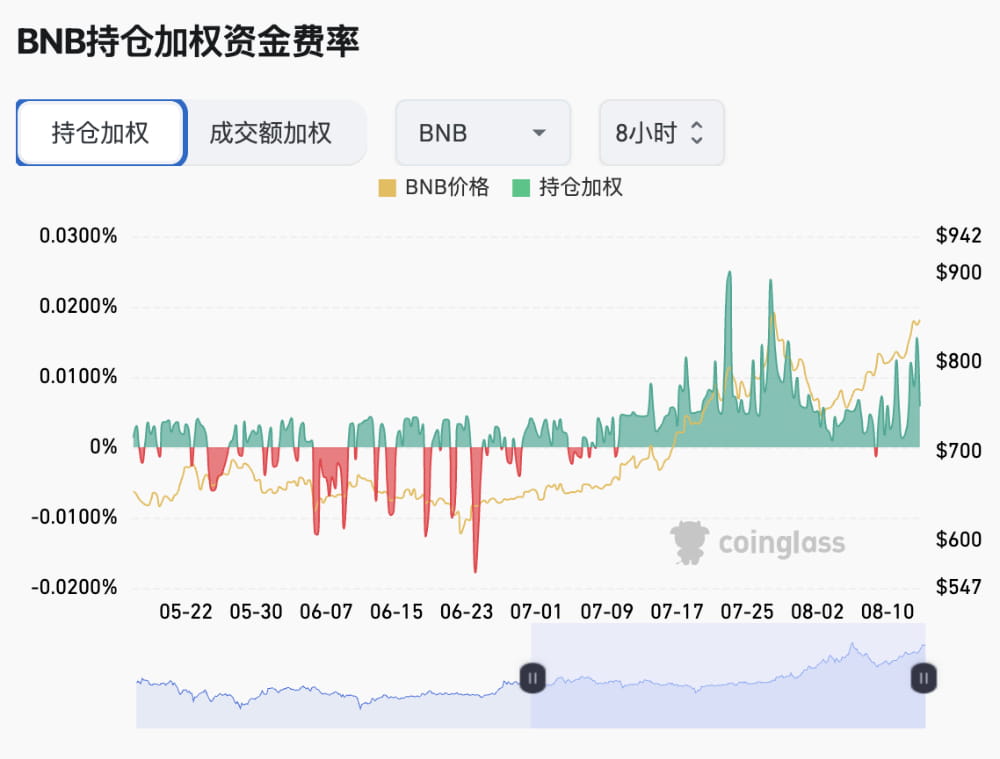
Source: Coinglass
The above events reflect BNB's institutional transformation, expanding from the past reliance on Binance's internal value support to a new phase actively configured by traditional institutions. When "Wall Street-style" buying pressure surges, there is structural upward momentum for BNB's value center, leading to a more long-term and stable source of demand. For retail investors, it is necessary to reassess BNB's long-term potential at this time and share in the rising dividends of BNB through various means.
02. Retail Opportunity 1: On-Chain Play of BNB Chain
For retail investors, actively participating in the BNB ecosystem on-chain is an important way to gain incremental value, allowing participation in BNB Chain's dividends through various methods such as DeFi, RWA, and Meme.
DeFi: The leading DEX and lending protocols on the BNB Chain currently rank among the industry's top. For example, the leading decentralized exchange PancakeSwap (V3) has a TVL of about $2 billion, providing liquidity pool yields for various currency pairs; the established lending protocol Venus supports lending of mainstream assets like BNB; Lista DAO has also reached a TVL scale of $1 billion. Retail investors can choose suitable DeFi strategies based on their risk preferences (as shown in the chart below).
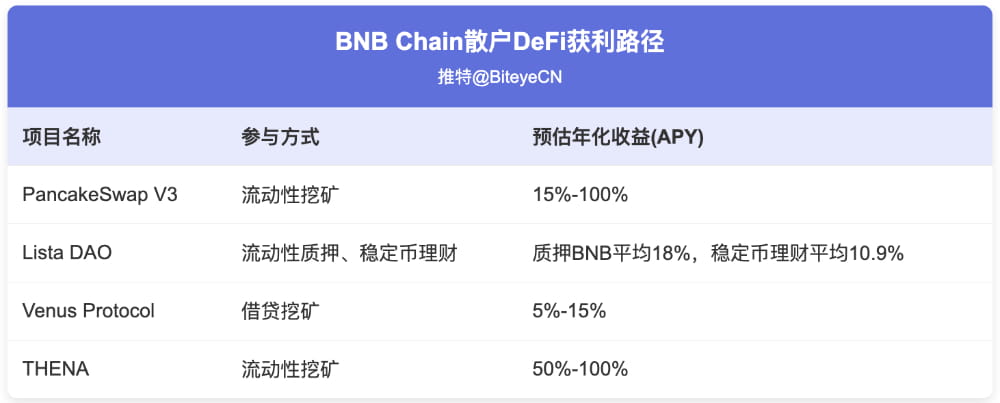
RWA: The BNB Chain is rapidly becoming an emerging platform for RWA on-chain. Ondo Finance announced in July the introduction of its tokenized products for over 100 U.S. stocks and ETFs to the BNB Chain, allowing global users to trade portions of U.S. stock assets 24/7 without interruption. At the same time, Kraken and asset management firm Backed's xStocks program will also be deployed on the BNB Chain, supporting trading of over 60 U.S. stocks and ETFs. In terms of stablecoins, Trump's family company WLFI chose to launch the compliant stablecoin USD1 on the BNB Chain, which has now integrated into the BNB Chain DeFi system and established a USD1 liquidity pool. Retail investors can more conveniently invest in U.S. stocks, U.S. bonds, etc., achieving diversified asset allocation.
Meme: At the beginning of the year, several phenomenal Meme tokens were born on the BNB Chain, with unprecedented market heat. If you are interested in trading Meme coins, you can scan the chain on the first Meme fair launch platform on the BNB Chain, Four.meme, and pay attention to newly deployed tokens. Of course, keep in mind that Meme market conditions can change rapidly; currently, enthusiasm has significantly decreased, and it is best to wait for a resurgence in heat before investing. From the perspective of market opportunities, Meme enthusiasm can bring considerable trading volume and new users to the BNB Chain, further increasing demand for BNB, indirectly benefiting BNB holders.
Overall, the BNB Chain ecosystem is currently in a rising phase of inflow of traffic and value. For retail investors, this also means that on-chain opportunities are gradually exploding, allowing for stable earnings in blue-chip DeFi projects and attempts at RWA plays, or even discovering dark horse Memes. As the core value carrier of the BNB Chain, the on-chain prosperity will ultimately translate into value support for BNB. Therefore, by deeply participating in the BNB Chain ecosystem, it is actually growing together with BNB.
03. Retail Opportunity 2: Coin-Stock Resonance, "BNB Concept Stock" Positioning Strategy
In simple terms, when a listed company announces a significant purchase of BNB or incorporates BNB into its financial strategy, the trends of these stocks begin to become highly correlated with BNB. When BNB surges, they often experience synchronous or disproportionate increases, and vice versa. Therefore, if there is confidence in the fundamentals of BNB, it may be worth considering positioning related concept stocks before the market takes off. For example, MicroStrategy's continuous buying of Bitcoin means that retail investors buying MicroStrategy's stock are indirectly betting on Bitcoin's performance, and MicroStrategy's stock price can sometimes even exceed Bitcoin's gains during the same period. Now, with the rise of institutional accumulation of BNB, there is hope to replicate this kind of coin-stock resonance effect.
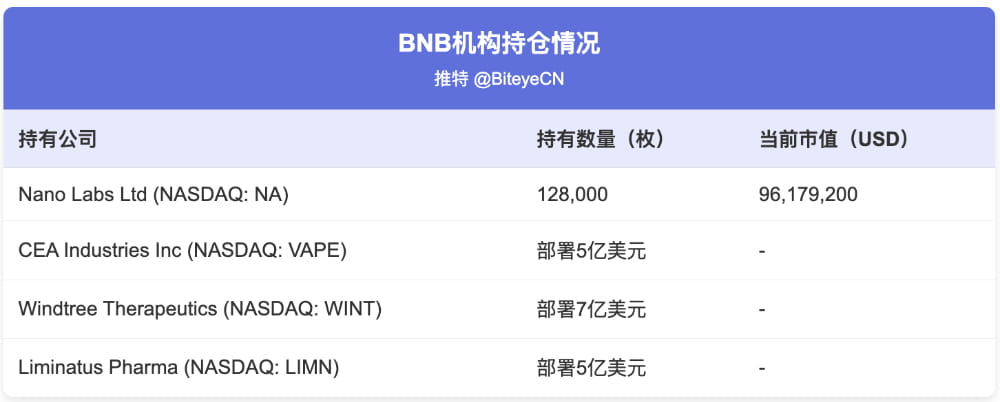
As mentioned earlier, several companies plan to incorporate BNB into their asset reserves (as shown above), and their stocks are highly correlated with BNB. So how should retail investors operate and manage risk?
Grasp the information rhythm: Closely monitor the announcement timing of the aforementioned companies regarding BNB. Often, stock prices have already surged at the moment the news is announced, and chasing high afterward increases the risk. For example, pay attention to key nodes such as SEC documents, additional fundraising, completion of purchases, etc. Positioning at a low before the news, and when the news materializes, you can choose to take profits in batches.
Pay attention to BNB price linkage: These stocks are highly correlated with the price of BNB. For example, when BNB broke above $800 at the end of July, CEA, Windtree, and others followed suit intraday, and vice versa, stocks may also experience some pullbacks. Therefore, BNB's market movements can be used as a leading indicator; if it is judged that BNB will start a new wave of upward movement, relevant stocks can be correspondingly increased to wait for resonance. However, caution is advised, as if BNB experiences significant volatility, stocks may have even more severe roller coaster fluctuations.
Pay attention to the relationship between concept stocks and Binance: Some stocks have stronger market confidence due to the involvement of Binance or CZ. Therefore, you can watch for any further cooperation support from the official side with these companies, such as whether they provide custody, strategic guidance, etc. These signals will enhance market trust in concept stocks holding BNB, thus boosting valuations.
It is worth noting that these opportunities carry dual risks, being influenced both by the volatility of the crypto market and the inherent factors of the stock market (such as financing dilution, etc.). It is recommended that everyone try a small amount, strictly control positions, and timely track fundamentals.
04. Retail Opportunity 3: Exchange Play
In recent years, Binance has launched various activities such as Launchpad, Launchpool, and Megadrop, most of which are related to BNB. In fact, utilizing exchange activities effectively transforms BNB from a pure investment product into a tool for obtaining diversified returns, allowing for appreciation of BNB itself as well as additional earnings.
The table below summarizes several mainstream Binance initial mining activities to help everyone choose suitable ways to earn money based on their circumstances.
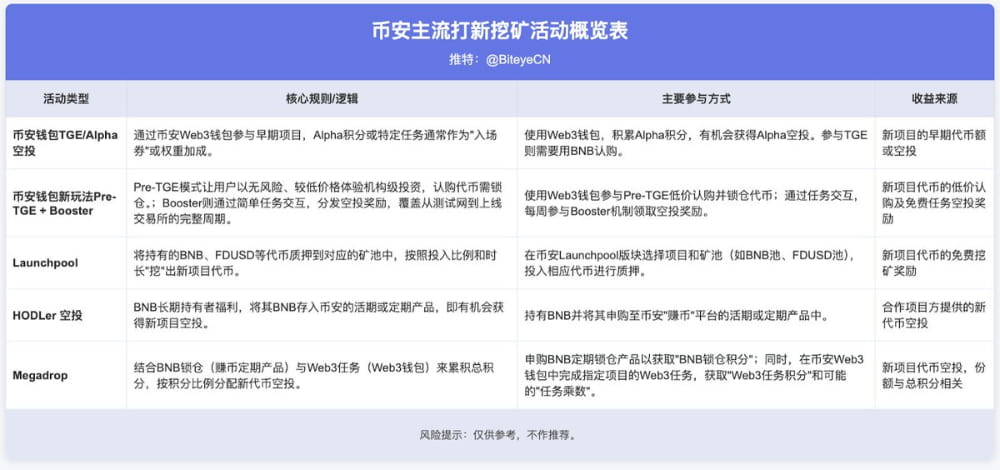
You can choose a suitable strategy based on your own capital size and time investment:
Conservative holding type: If funds are relatively abundant but you do not want to spend too much energy, you can adopt the "BNB Holding Party" strategy. This means holding a certain amount of BNB for the long term and actively participating in Launchpool and periodic HODLer airdrop activities. This strategy focuses on generating coins from coins, with returns coming from both the appreciation of BNB and the dual addition of airdropped new coins.
Active participation type: If funds are limited but time is ample and you have strong hands-on ability, you can try the "Alpha points party" route, aiming to reach the point thresholds for airdrops/TGE, Pre-TGE, and Booster. After completing the tasks, exit in a timely manner to lock in profits. It is emphasized that this strategy must calculate costs to avoid losses due to high transaction fees and slippage.
In addition to the major activities mentioned above, Binance also provides a series of benefits for BNB holders, such as VIP levels, fee discounts, voting for new listings, and Binance Pay cashback. For instance, using BNB to deduct fees in Binance spot and futures trading can enjoy discounts. In addition, BNB holders can also participate in some exclusive financial products of Binance Earn, achieving multiple layered benefits.
05. Retail Opportunity 4: Holding BNB, Deflationary Dividends and Token Economic Model
Regardless of the participation in any play, the vast majority of paths ultimately cannot be separated from holding BNB. One core reason many people are optimistic about holding BNB is its deflationary token economic model, which is the only deflationary token among the top market cap tokens. As of July 2025, approximately 60 million BNB have been destroyed cumulatively (accounting for about 31% of the initial supply), with the circulating supply reduced from 200 million to about 139 million. It is expected that in the coming years, BNB will reach the target of a constant supply of 100 million.
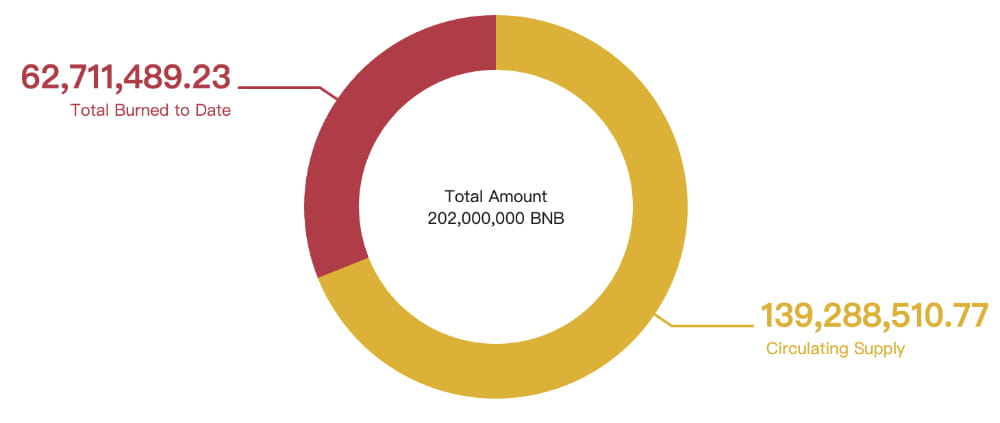
Source: bnbburn.info, Binance Research Institute
Automatic destruction mechanism: The earliest destruction method for BNB was based on BNB trading volume on the Binance trading platform. Starting from the fourth quarter of 2021, a new automatic destruction algorithm was introduced, dynamically adjusting based on BNB prices and the number of blocks generated on the BNB Chain. For example, in the recently completed 32nd BNB quarterly destruction, a total of 1,595,599.78 BNB was destroyed, valued at approximately $1.024 billion at the execution price.
The formula for the automatic destruction mechanism is shown below, where B represents the number of BNB to be destroyed this quarter, N represents the total number of blocks produced on the BNB Chain this quarter (the quantity is determined by the fixed block time), P represents the average price of BNB, and K is a constant (currently set to 250 after the hard fork upgrade). From the formula, it can be seen that when the price is higher, the amount destroyed is less, and vice versa. The essence of this mechanism is to increase the deflationary intensity during market downturns to maintain BNB's value anchor by reducing circulation; while during market booms, it automatically lowers the destruction intensity to avoid excessive tightening of supply.

Real-time destruction mechanism: In addition to quarterly centralized destruction, the BNB Chain introduced the BEP-95 protocol in 2021 to achieve on-chain real-time destruction. A fixed proportion of the Gas fee paid for each BNB Chain transaction will be directly burned. The more prosperous BNB becomes, the more BNB will be burned. In the long term, the growth of on-chain activity will also drive an increase in trading volume, triggering more real-time destruction.
For retail investors, the deflation of BNB means increased scarcity. Assuming stable or growing demand, a decrease in supply will push up the intrinsic value of each token. This is similar to a listed company continuously repurchasing its stock, increasing earnings per share and net assets, thereby benefiting the stock price. It is worth noting that the commitment for BNB is around 100 million, and it will not decrease indefinitely to avoid affecting network operational security. Therefore, as it approaches 100 million, attention needs to be paid to whether policies are adjusted, such as switching to maintain a constant inflation rate, etc. But at least for the next few years, the deflationary trend is clear.
06. BNB Value Reassessment and Future Outlook
With the entry of institutions, traditional financial institutions are also changing their reassessment of BNB's value. For example, Standard Chartered Bank noted in a report this May that it expects the price of BNB to double by the end of 2025, reaching about $1,275, and is expected to further rise to around $2,775 by the end of 2028.
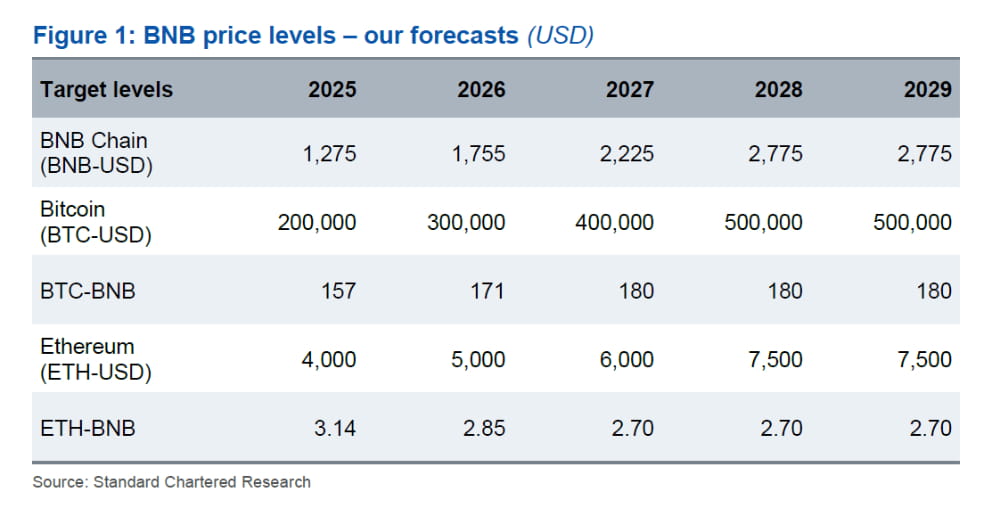
Source: Standard Chartered Bank (for reference only)
In addition, BNB's development in the payment sector will also provide additional support for its value, further driving the market to adjust its valuation model. Binance's payment application Binance Pay has been promoted globally, using BNB as one of the important settlement currencies. Data shows that Binance Pay has processed 300 million transactions, with a total transaction volume of $230 billion, a significant portion of which uses BNB for transactions. For example, in the French Riviera region, Binance has collaborated with fintech Lyzi to enable over 80 local merchants to support cryptocurrency payments, including various currencies such as BNB. If this trend continues, the demand for BNB will come not only from investment and trading but also from real commercial circulation.
Overall, as of mid-2025, BNB is in an upward channel of value reassessment. Institutional accumulation gives it the narrative of "digital gold reserve," ecological prosperity gives it the narrative of "public chain leader," and payment expansion gives it the narrative of "utility currency." The multiple narratives overlapping provide BNB with further imagination space for market capitalization increase. At the same time, it should be kept rational; the long-term value of BNB ultimately depends on whether the ecosystem can continue to build and maintain innovation and stable operations in a constantly changing market.
07. Conclusion
From the initial platform token, popular public chain token, to becoming a crypto asset configured by traditional institutional investors, BNB's transformation also reflects the maturity of the crypto industry. In the wave of institutional accumulation, retail investors can share in the value growth of BNB through deep on-chain participation, layout of related concept stocks, participation in exchange activities, and holding BNB. As the slogan goes, "Build and Build," the value of BNB will be shaped by everyone's joint participation. Looking ahead, can BNB, driven by the joint efforts of institutions and retail investors, open a new era of innovation? Let's wait and see.



